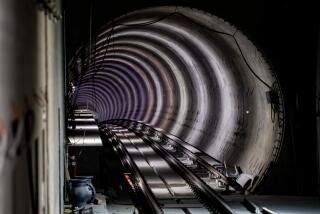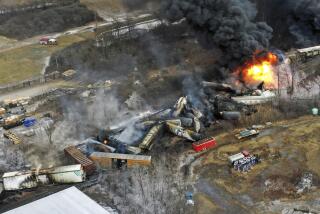Capital Mixes Signals for Amtrak
WASHINGTON — WASHINGTON -- When it comes to funding highways, runways and even subways, politicians start from a consensus that the transportation system must keep moving.
That’s not the case with Amtrak.
Even if the Bush administration delivers on its promise to avert a shutdown by providing federal guarantees for emergency loans, the national passenger rail corporation will remain on the verge of becoming another railroad relic.
The reason is fundamental: Although the interstates and the air traffic control system are considered public infrastructure, Amtrak had been expected to wean itself of federal operating subsidies by the end of this year. It’s evident that won’t happen now.
Amtrak loses $1.05 for every $1 it makes in revenue. To cover its losses, it went on a late-1990s borrowing spree that piled up $4 billion in debt, including a $300-million mortgage on New York’s Penn Station. Amtrak ridership, while growing, has not kept pace with internal goals.
Kenneth Mead, inspector general of the Transportation Department, said Amtrak cannot keep operating if its cash flow problems continue to mount. “If this is the case, Amtrak will be back before Congress next summer in a similar situation asking for additional funds,” he said.
Tuesday, Amtrak’s president announced that any decision on shutting down the system will be postponed until July 4 or 5, citing progress by the administration and in Congress to secure $200 million in emergency financing.
Amtrak is also asking the Bush administration for $1.2 billion for the coming fiscal year beginning Oct. 1, more than twice as much as the White House wants to spend.
The administration and powerful Democrats in Congress remain at odds over the future of the passenger rail system.
Bush favors pushing Amtrak toward the free market and partnership with the states, breaking it into smaller regional units and opening choice routes to private competition.
Democrats want to infuse Amtrak with a steady appropriation of cash, arguing that the goal of turning it into a profitable system was unrealistic from the start.
Caught in the middle are Amtrak’s 23,400 employees and roughly 64,000 daily riders, more than half of whom travel on the Northeast Corridor between Washington and Boston. Hundreds of thousands of rail commuters on both coasts, whose trains depend on Amtrak support services, could also face at least temporary disruptions if there is a shutdown.
Even if Amtrak survives, several interstate trains serving California are likely targets for cancellation. Among them are the Coast Starlight, between Los Angeles and Seattle, and the California Zephyr, linking Chicago and the Bay Area.
However, California also is a model of what a reformed Amtrak might look like. The state has invested heavily in commuter rail and intercity routes that now carry more daily riders within California than Amtrak does nationally.
The Bush administration is hoping to convince other states to do likewise.
What could save Amtrak is a compromise over its long-term future.
The administration would finally have to accept Amtrak as a legitimate part of the public infrastructure and agree to continue federal subsidies, probably at higher levels than it would like.
Democrats, meanwhile, would have to accept a restructuring that eliminates cherished routes. The vehicle for such an agreement would be legislation, now pending in Congress, to set a new government policy for Amtrak.
Transportation Secretary Norman Y. Mineta says he is committed to preserving intercity passenger train service, but he adds that Amtrak must undergo radical change.
“Amtrak’s current route network provides too many services with limited market appeal at high operating costs to the federal government,” Mineta said. “The country can ill afford to throw billions of federal dollars at Amtrak and just hope its problems disappear.”
Democrats in Congress bristle at such language from Mineta, a former colleague serving a GOP administration. They have roundly condemned Bush’s program as a “non-starter.”
“From the outset, Amtrak has been on a starvation diet,” said Rep. James L. Oberstar (D-Minn). “No nation in the world has successfully operated intercity passenger trains on a for-profit basis.”
As for the Bush plan, “it was not worth the wait,” Oberstar said.
One thing that the administration and the Democrats agree on is that Amtrak is finally under capable management. David Gunn, a veteran manager with a reputation for reviving dying public transit systems, was coaxed out of retirement in Canada to take over at Amtrak in April.
“I have run larger organizations than Amtrak, but I do not recall in nearly 40 years of service taking the reins of a company with such immediate and significant problems,” Gunn said. “When you have to mortgage your busiest station just to make payroll, you are only a step or two before the precipice.”
Gunn’s credits include turning around the New York and Philadelphia public transit systems and running Washington’s Metro subway system.
Among the problems he said he found at Amtrak was a company with 85 vice presidents, many with titles such as “senior” and “executive.” The budget “was a document based on unrealistic assumptions.”
Meanwhile, one in 15 cars were out of service because Amtrak has postponed needed maintenance and repairs.
“The company made bad decisions while pursuing an impossible goal of self-sufficiency mandated by Congress,” Gunn said. “Despite these problems, Amtrak and the service it provides are well worth saving.”
Defining himself as a traditional transit manager, Gunn said he opposes privatization. “Most of our trains lose money and they always will, but we can run them more efficiently,” he said. “That is an achievable goal.”
Gunn said the administration has been pushing Amtrak to raise about half of the $200 million in emergency funding on its own, even floating a proposal to mortgage Chicago’s Union Station. That and most of the other proposals have turned out to be impractical, he said. But Mineta has not pressed him to cut any routes for now.
Historically, long-distance passenger rail service was operated by independent businesses. But with the privately run system facing economic extinction, Congress established Amtrak in 1970 as a for-profit corporation. It has not had a profitable year in the three decades since.
Even service in the Northeast Corridor, where Amtrak owns the rails and the trains, loses money.
Privatization would not be a cost-free option. An analysis earlier this year by the Transportation Department inspector general’s office concluded that buyers would balk at the high cost of long-neglected improvements to Amtrak’s infrastructure. For example, the Northeast Corridor--Amtrak’s most attractive asset--needs $15 billion in long-term capital improvements.
“Few investors would find it a good bargain,” said Mead, the inspector general. “For the Northeast Corridor to become marketable, the capital needs must first be addressed, which leads us back to the funding question already on the table: How much will it cost, who pays, and how?”
More to Read
Sign up for Essential California
The most important California stories and recommendations in your inbox every morning.
You may occasionally receive promotional content from the Los Angeles Times.










